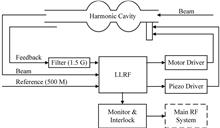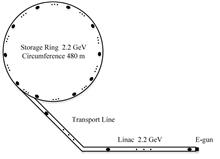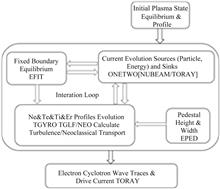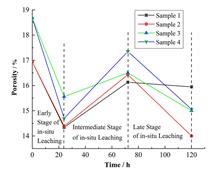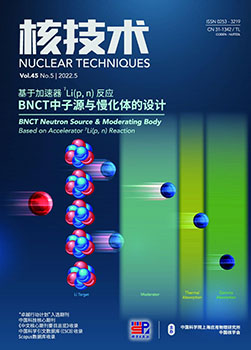
BackgroundThe superconducting third harmonic cavity has been developed independently in Shanghai Synchrotron Radiation Facility (SSRF) and passed beam tests. The cavity electric field needs to be precisely controlled during operation to achieve the goal of stretching beam cluster and improving beam life.PurposeThis study aims to design a digital low level radio frequency (DLLRF) controller for superconducting third harmonic cavity at SSRF.MethodsThe hardware of controller was based on a field-programmable gate array (FPGA) board and a front-end board whilst in-phase/quadrature (I/Q) demodulation techniques were implemented in the software of controller. A synergistic strategy was adopted for driving the stepper motor with slow tuning speed and piezoelectric ceramic with fast tuning speed, and an algorithm for the quench detection for passive cavity. Finally, experimental tests were performed to verify the effectiveness of this designed DLLRF.ResultsWhen the state is in top-up mode over 120 mA, the amplitude stability has improved form ±5% with open loop to less than ±1% with close loop, the voltage of piezo has varies smoothly and stably within 120 V, and the beam life has improved more than doubled.ConclusionA digital low level radio frequency controller for the superconducting third harmonic cavity has been designed and satisfies the requirements for SSRF.
BackgroundHefei Advanced Light Facility (HALF) is a fourth-generation synchrotron radiation light source based on diffraction-limited storage ring. The timing system provides trigger signals for the HALF injector, storage ring and beamline, coordinates injection and beam measurement, and achieves filling of the storage ring bucket with any designated bunch pattern.PurposeThis study aims to design a timing system for HALF to reduce the trigger signal jitter of the HALF device to less than 30 ps, and stabilize the signal drift caused by the optical fiber length change.MethodsBased on the MTCA.4 event-driven products from Micro-Research Finland Oy (MRF), the event timing technology scheme was adopted to implement the timing system. Appropriate system frequencies for electron gun, microwave system and storage ring were selected to achieve different modes of storage ring bucket filling scheme. The timing system software was developed under Experimental Physics and Industrial Control System (EPICS) to coordinate with the control system of HALF, including an EPICS driver, database records, and operation interfaces. Delay compensation was applied to signal drift caused by the variation of optical fiber length. Finally, a prototype of the timing system was developed for performance tests.Results & ConclusionsThe results show that the jitter of the trigger signal is less than 24 ps, and the signal drift is controlled at about 3 ps after delay compensation, both meet the design requirements of HALF timing system.
BackgroundIn recent years, electron cyclotron wave (ECW) heating and current drive (ECCD) have been widely used in tokamak discharge experiments. The inevitable presence of impurity particles in the tokamak plasma affects the ECCD through radiation energy, inhibition of turbulent transport, and change the collision rate. Changes in plasma density, temperature and other transport quantities caused by the change of impurity concentration, induce the changes of Shafranov displacement at the center of magnetic surface of the plasma.PurposeThis study aims to investigate the influence of impurity concentration changes on the ECW deposition position and current drive efficiency theoretically with consideration of all above related variations.MethodsThe One Modeling Framework for Integrated Tasks (OMFIT) platform was used to conduct integrated simulation study of the effect of impurity effect on ECW heating and current drive. The HL-2M Tokamak device parameters were combined with self-consistent coupled plasma equilibrium, external auxiliary heating and current drive, transport and other physical processes for simulation computation with the carbon ions as the unique impurity ions.ResultsThe simulation results show that when the influence of impurities on the plasma is considered, with the increase of the impurity concentration, the radial position of the ECW deposition first moves to the plasma core and then moves to the edge, and the current drive efficiency first increases and then decreases. Due to the competition between the radiation effect and the dilution effect of the impurity-plasma interaction, the radiation loss power basically increases linearly with the increase of Zeff, while the dilution effect suppresses the turbulence and improve the confinement, but the stabilization effect slows down with the increase of Zeff.ConclusionsWhen the influence of impurities on the plasma is not considered, the deposition position of ECW is basically unchanged, and the current drive efficiency decreases. Results of this study have guiding significance for electron cyclotron current drive (ECCD) to control the plasma current profile and control the instability of magnetic fluid.
BackgroundIn recent years, lead halide perovskite scintillators have received extensive attention in the field of X-ray imaging. Hard X-ray medical imaging in energy range of 20~120 keV using scintillator detectors, sensitivity and imaging spatial resolution are important performance indicators.PurposeThis study aims to explore X-ray imaging property of halide lead perovskite scintillators by simulation.MethodsFirst of all, 3D MAPbBr 3 quantum dots/polystyrene and 2D PEA 2PbBr 4 quantum dots/polystyrene scintillators were taken as research objects. Then, simulation code Geant4 was employed to establish detector model and simulate the X-ray relative detection efficiency and imaging spatial resolution of lead halide perovskite quantum dots/polymer composite scintillators. Finally, the effect of energy and the ratio of perovskite quantum dot occupation on the resolution were explained by secondary electron motion.ResultsThe results show that increasing the thickness of the composite scintillator and the proportion of perovskite quantum dots can improve the relative detection efficiency whilst reducing the thickness and increasing the proportion of perovskite quantum dots can improve the spatial resolution. When the absorption efficiency reaches 99.5%, 80% of 3D MAPbBr 3 quantum dots/polystyrene excited by 20 keV X ray obtain the same spatial resolution of 10 lp·mm-1 as CsI. When the incident energy increases to 50 keV, the spatial resolution of CsI is 8 lp·mm-1, while that of lead halide perovskite scintillators is less than 4 lp·mm-1.ConclusionsIt is shown by this study that lead halide perovskites have certain application potential in 20 keV low-energy X-ray medical imaging.
BackgroundIn the process of in-situ leaching of uranium, pore blockage greatly limits the leaching efficiency of uranium, and the pore blockage is mainly due to the complex physical and chemical action of minerals and leaching agents in in-situ leaching of uranium.PurposeThis study aims at the influence mechanism of each mineral composition on pore blockage under the action of leaching agent in the process of in-situ leaching of uranium to realize the efficient exploitation of uranium resources.MethodsFirst of all, sandstones of uranium mine in Xinjiang were taken as the experimental samples, the relationship between the mineral composition and porosity in the process of acid in-situ leaching of uranium was studied through acid in-situ leaching experiment, and nuclear magnetic resonance experiment was employed every other period of time to obtain the porosity change curve in the process of uranium sandstone leaching. Then, the mineral characteristics of uranium sandstone were analyzed by X-ray diffractometer to find the changes of the mineral composition during uranium sandstone leaching. Finally, the influence of different minerals on porosity change was analyzed with the help of gray relational theory.ResultsThe results show that the pore blockage in the leaching process is mainly due to the complex physical and chemical action of many kinds of minerals, which will affect the solute transport process of other minerals in uranium sandstone and not only lead to the change of mineral composition but also affect the leaching of uranium. Through grey correlation analysis, it is found that calcium sulfate and magnesium silicate as plugging materials have a correlation degree of over 0.781 for porosity and uranium leaching rate. The physical adsorption of clay minerals can block the micropores of uranium sandstone, so its correlation with porosity and uranium leaching is 0.831 and 0.842 respectively, indicating that pore plugging has an impact on uranium leaching.ConclusionsAccording to the relationship between the change of mineral composition and pore blockage in the process of leaching, making appropriate adjustment can solve the problem of pore blockage, so as to realize the efficient exploitation of uranium resources.
BackgroundRemote, large-scale, rapid and real-time detection of radioactive sources is of great significance for industrial investigation and environmental remediation. Gama camera can extract information such as the location, intensity and category of radioactive substances from a long distance, and is an effective detection tool. Due to the small detector area and the limited field of view (FOV) of the coded aperture, the detection efficiency of the current coded aperture γ cameras is low.PurposeThis study aims to propose a prototype of large area and highly sensitive coded aperture gamma imaging system based on a SPECT probe.MethodsFirst of all, the Hamamatsu BHP6601 single photon emission computed tomography (SPECT) probe with large area of 510 mm×390 mm and high intrinsic spatial resolution of 3.55 mm was selected as the detector of the system. Based on the detector by tectonic analysis, modified uniform redundant arrays (MURA) coding nesting mode was adopted with a rank of 23 and each unit aperture size of 22.1 mm×17 mm. Then, the system transmission matrix is obtained by using the gamma rays emitted from the radioactive sources at different angles of the FOV to reach the detector geometry through the coded aperture. Then, the geometric relationship between the radioactive source and the system is used to analyze and construct different radioactive source events. Next, the cumulative probability based on the system transmission matrix simulates the photon distribution on the detector. Finally, using Maximum Likelihood Expectation Maximization (MLEM) algorithm is built source image.ResultsThe results indicate that the non artifact field of view (NAFOV) is 57.32° in the X direction and 47.3° in the Y direction; and the spatial angle resolution is 2.94° in the X direction and 2.28° in the Y direction. The γ camera can accurately locate 3.7×107 Bq 137Cs single point source in 1 s at the distance of 18 m and 2 s to accurately reconstruct the position of 1.11×106 Bq 137Cs at the distance of 4 m away from the camera.ConclusionsThe γ camera of this study has a high detection capability for distant or low-activity radiation sources in large range.
BackgroundCu-W composites are widely used in electric power, electronics, and plastic forming owing to the excellent electrical and thermal conductivities of copper combined with the outstanding strength and thermal properties of tungsten.PurposeThis study aims to investigate the extension of the solid solubility of the Cu-W immiscible system under high current pulsed electron beam (HCPEB) irradiation.MethodsFirst of all, the Cu-15W powder mixture was sintered by vacuum at 850 ℃ after ball milling for 5 h to prepare the Cu-W composites. After polishing, the Cu-W composites was exposed by a HOPE-1 type HCPEB device with 1, 5, 10 and 15 pulses, respectively. Then, Rigaku D/Max-2500/pc X-ray diffractometer (XRD) was used to analyze the phase constitutes of the milling powder, sintered samples and irradiated samples. The surface morphology was observed by JEOL JSM-7001F field emission scanning electron microscope (SEM). The energy dispersive spectrometer (EDS) in SEM was used for the examination of micro-region composition. Finally, the microstructures in the modified layer were characterized by JEOL-2100F transmission electron microscopy (TEM). The surface hardness of the sintered and irradiated samples with different pulses was measured using the HVS-1000 Vickers hardness tester.ResultsThe results reveal that Cu(W) solid solutions were formed during the process of ball milling, and the mass fraction of the solute element W in the Cu(W) solid solution reaches 0.88% after 5 h of ball milling. It was discovered that the solid solution undergoes exsolution reaction during heating using differential scanning calorimeter (DSC). The sintered sample surface was irradiated by a pulsed electron beam. The results demonstrate the formation of solid solution phase after HCPEB irradiation, whose solubility increases with the increase of the number of pulses. After 10 pulse irradiations, the mass percentage of solute element (W) in Cu(W) solid solutions reaches 1.63%. The surface hardness of irradiated samples increases significantly after HCPEB irradiation, and reaches 237.1 HV after 10-pulsed irradiation. Surface hardening is primarily caused by of solid solution strengthening and dispersion strengthening.ConclusionsThe present paper provides a meaningful instruction for preparing the immiscible alloy with high solid solubility and the excellent performance.
BackgroundUN-U 3Si 2 composite fuels have a promising prospect in advanced future accident tolerant fuel elements. Its irradiation creep and thermal creep caused by in-reactor operation have an important influence on the irradiation-induced thermo-mechanical coupling behavior and safety of the fuel elements.PurposeThis study aims to develop a stochastic modeling method according to the metallographic structure of composite fuel and numerical simulation of the uniaxial tensile creep test of the UN-U 3Si 2 composite fuel (20% U 3Si 2).MethodsBased on the data of creep experiments from literatures, the dominated creep mechanisms of UN and U 3Si 2 polycrystalline fuels were analyzed, and their creep rate models considering vacancy diffusion and dislocation motion mechanisms were obtained by curve fitting. Then, the correlation model between the macroscopic creep of composite fuel and the contribution of each component was established on the basis of the homogenization theory and the removal of irradiation swelling effect. Finally, based on the metallographic structure diagram of composite fuels in the literatures, stochastic modeling method was developed and applied to the numerical simulation of the uniaxial tensile creep test of the UN-U 3Si 2 composite fuel (20% U 3Si 2).ResultsThe model predictions of UN and U 3Si 2 creep rates are in good agreement with the experimental results, validating the effectiveness of the model. The contribution of the component fuels to the macroscopic equivalent creep of the composite fuel is obtained by analysis of the underlying creep mechanism. When the fission density reaches 4.32×1027 fissions·m-3, the maximum von Mises stress at the interface between particles and matrix is about 6 times of the homogeneous tensile stress applied externally.ConclusionsThe research results indicate that the difference in the irradiation swelling of UN and U 3Si 2 will result in the strong internal mechanical interaction in the composite fuel whilst the existence of weakened stress regions leads to the negligible effect of irradiation swelling on the macroscopic equivalent creep strain of the composite fuel.
BackgroundTime series usually have the characteristics of linear and nonlinear. Single model has certain limitations, which proposes mixed models for time series prediction.PurposeThis study aims to explore the application of the combination of Mann-Kendall test, differential autoregressive mobile average model (ARIMA) and long and short-term memory (LSTM) used in the prediction of the number of operational events of nuclear power plants (NPP) collected in Nuclear Safety of China and Annual Report of Nuclear Safety.MethodsFirstly, the R software was used to build ARIMA (2,1,2) model to obtain the linear part of operation events with the number of nuclear power plant operation events from 1991 to 2018, and LSTM model was developed to predict the deviation sequences, hence the nonlinear part of the number of operation events was derived from those deviation sequences. Then, combined model of ARIMA and LSTM was established to predict the number of operational events. Finally, the predicted values based on measured data were verified by actual measured data.ResultsThe verification results show that the ARIMA and LSTM combination model can be employed to improve the prediction accuracy effectively by 3%, and the predicted values of operation events in nuclear power plants from 2019 to 2020 are similar to the data collected in Annual Report of Nuclear Safety.ConclusionsThe combined model can better fit the time series of the number of operating events of NPP and correct the error of the single model.
BackgroundThe annular fuel can increase the power density of the reactor due to its double-sided cooling, which is of great significance to the miniaturization and long-life operation of the pressurized water reactor.PurposeThis study aims at the calculation method of effective temperature of annular fuel cell by developing the thermal-hydraulic analysis code named THCAFS (Thermal-Hydraulic Code of Annular Fuel with Single channel) for annular fuel, and establishing a calculation model for the effective temperature of the annular fuel cell.MethodsBased on THCAFS, the thermal-hydraulic performance of the annular fuel cell designed by Westinghouse 4-loop PWR was analyzed, and the Code-to-Code comparison was carried out with the calculation results of VIPRE-01, TAFIX and NACAF. At the same time, the Monte Carlo code SERPENT was employed to simulate the radial power distribution and burnup process in the fuel rod, and the self-developed code THCAFS was used to simulate the thermodynamic behavior in the fuel rod, and the radial power distribution, nuclide density change and cell temperature field.Results & ConclusionsThe results show that THCAFS can be preliminarily applied to annular fuel design and thermal-hydraulic analysis. The maximum deviation of the ratio between the fitting function power and the simulated power under different fuel consumption does not exceed 2%. This effective temperature calculation method can also provide important reference value for the mechanism study of the relevant annular fuel resonance effective temperature.
BackgroundThe startup time and startup-failure are widespread in most cold redundancy equipment of nuclear power plants (NPPs). The traditional static and dynamic fault tree cannot accurately model the startup time and startup-failure.PurposeThis study aims to model the startup time and startup-failure behaviors in cold redundancy systems, and provide suggestions for the improvement of reliability assessment methods.MethodsFirst, a DFT Monte Carlo simulation method was proposed for modeling and analyzing equipment's startup time and startup-failure behaviors in a cold redundancy system. Then, the emergency diesel generator set of the nuclear power plant was taken as an example, the distribution curve of system failure probability and the sensitivity of each component were obtained. Finally, the results were compared with the static fault tree method and traditional DFT method.Results1) The proposed method can model and analyze the start-up time and start-up failure behaviors of cold redundant equipment, reflecting the real failure scenarios and actual operation status of cold redundant systems. 2) The proposed method can accurately evaluate the system failure probability, identify highly sensitive equipment parameters in different time periods, and analyze the influence of start-up time on the system failure probability.ConclusionsThe proposed method has certain theoretical significance for the optimal design of NPP's cold redundancy systems.
BackgroundWhen steam generator tube rupture (SGTR) occurs in the lead-bismuth cooled fast reactor, high pressure water/steam flows into the primary side filled with high temperature liquid metal. According to the location and size of the rupture, the leakage behaviors of the rupture may involve leak-before-break (LBB), single-phase critical flow or two-phase critical flow. Under the action of high temperature liquid metal, different forms of heat and mass transfer behaviors occur in the two-component multiphase system of water-metal, which has an important influence on the safe operation of the lead-bismuth cooled fast reactor.PurposeThis study aims at the bubble dynamic behavior in the descending flow field of liquid lead-bismuth alloy (LBE) in the tube bundle in different stages of SGTR caused by microcrack on the surface of the heat transfer tube during the drying stage and low flow single phase steam permeates the primary side.MethodsBased on the VOF method, a numerical simulation model of steam-LBE two-phase flow and phase interface capture was established to study the bubble growth and transport behaviors from single tube or 3×3 tube bundle in the downward flow field of high temperature LBE. The SST k- ω model was employed to solve the turbulence equation. The physical law of steam bubble movement was analyzed and its influence on the heat transfer and operation stability of steam generator was evaluated.ResultsThe results show that the dynamics behaviors of steam bubbles in the descending flow field are quite different from these in static liquid or upward flow. The steam bubbles may slide along the heat transfer tube surface after departure from the crack under the actions of LBE descending flow field and buoyancy. The steam bubbles may form a steam film covering the heat transfer tube surface or accumulate by quantity in the bundle.ConclusionsThese phenomena adversely affects the flow stability of the LBE and the heat transfer of the steam generator.







